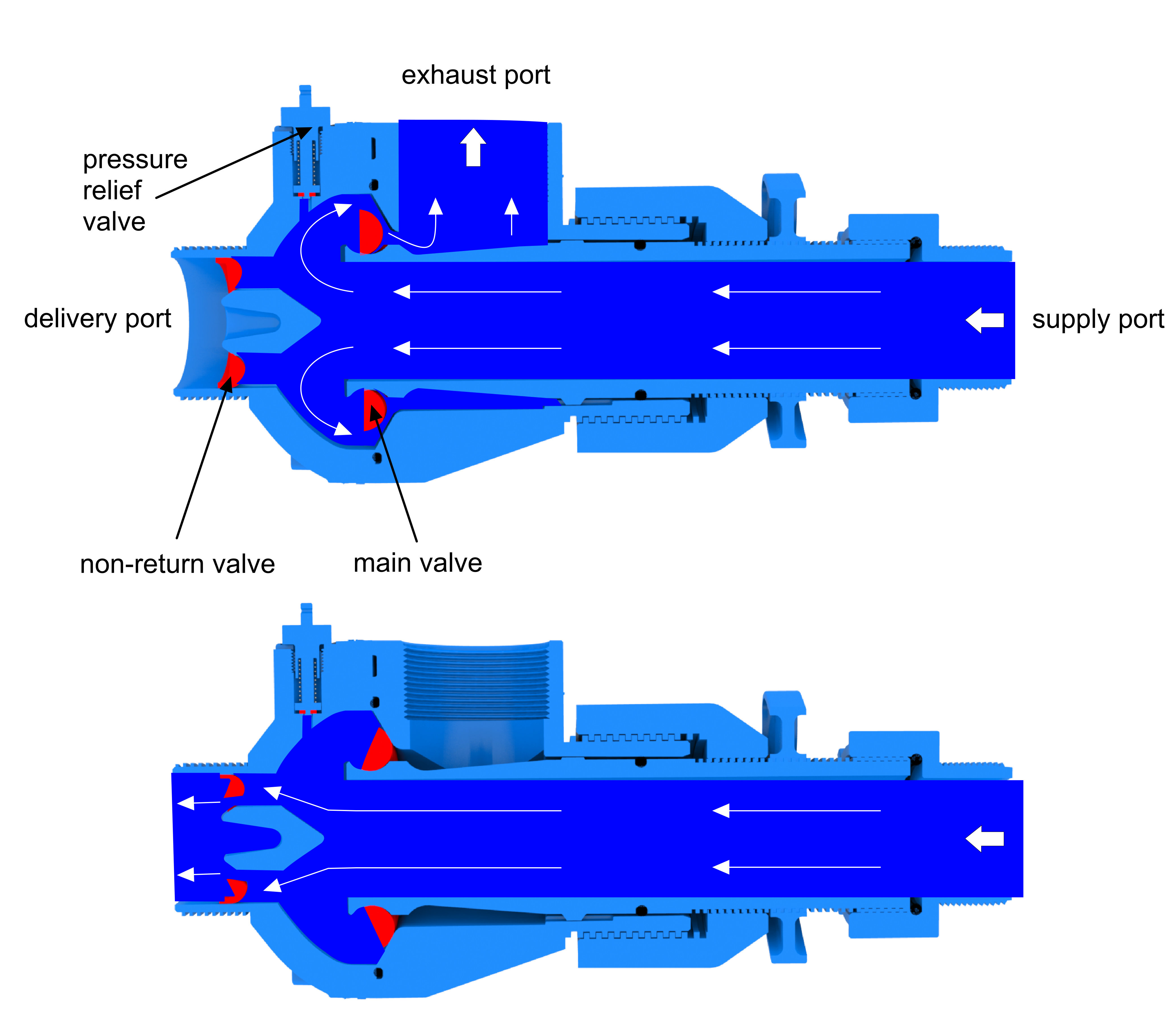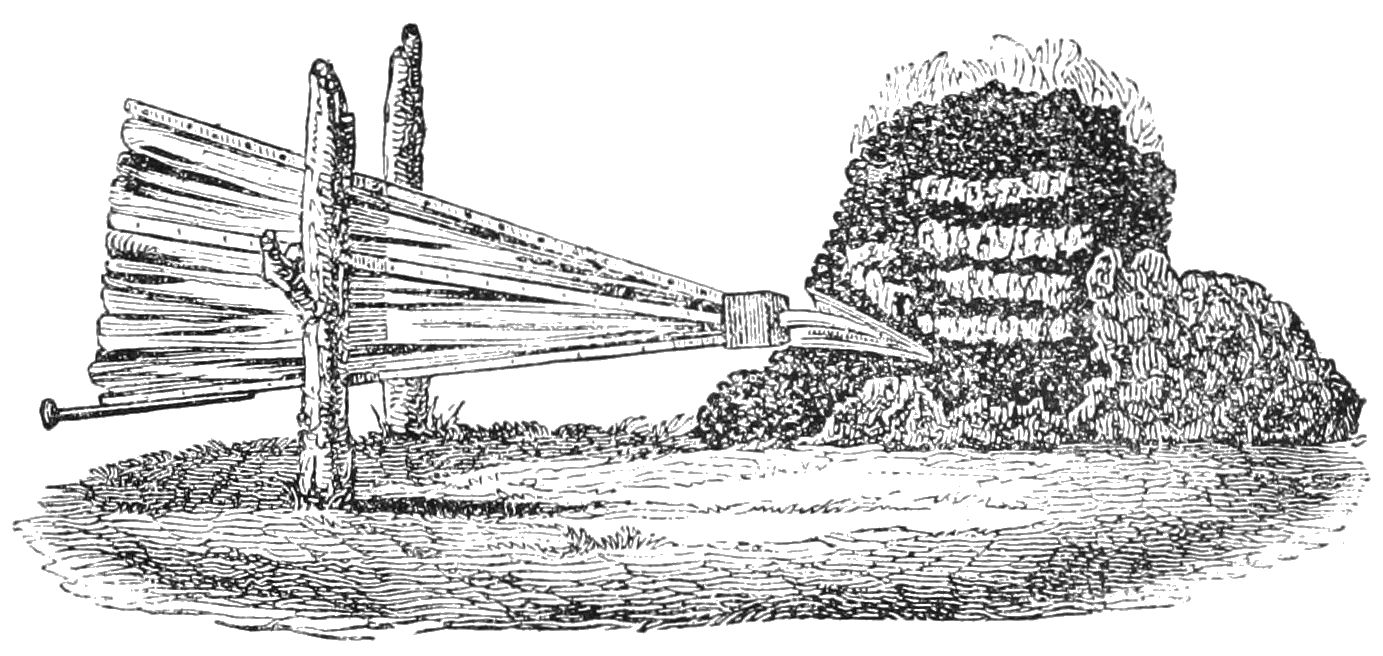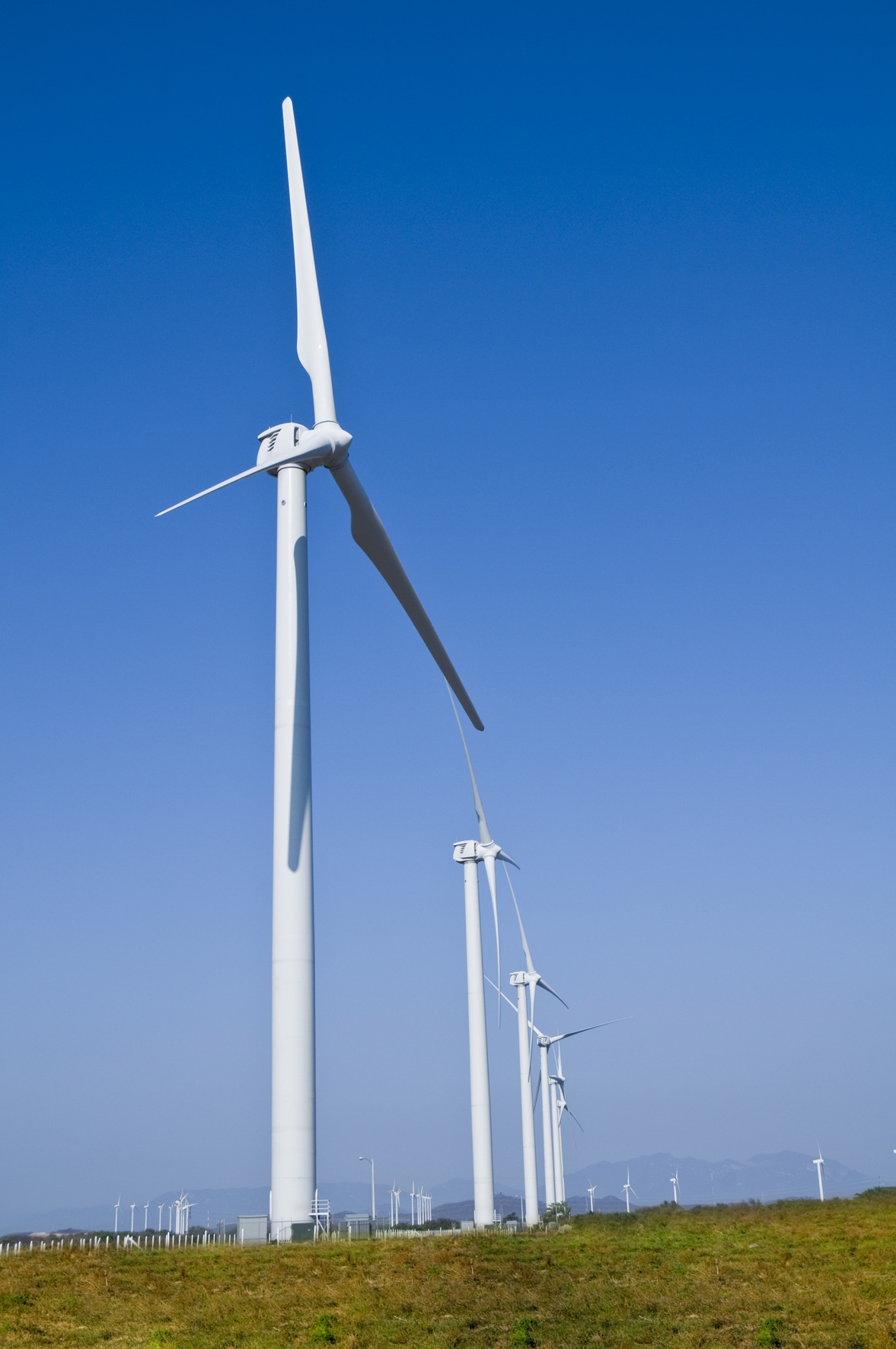|
Trompe
A trompe is a water-powered air compressor, commonly used before the advent of the electric-powered compressor. A trompe is somewhat like an airlift pump working in reverse. Trompes were used to provide compressed air for bloomery furnaces in Catalonia and the United States. The presence of a trompe is a signature attribute of a Catalan forge, a type of bloomery furnace. Trompes can be enormous. At Canadian Hydro Developers' Ragged Chute facility in New Liskeard, Ontario, water falls down a shaft deep and across to generate compressed air for mining equipment and ventilation.Ragged Chutes Operation Trompes are very simple devices. They consist of four main parts: a ''water-supply pipe'' or ''shaft'' with an ''air-inlet'' inside it, a ''water ...[...More Info...] [...Related Items...] OR: [Wikipedia] [Google] [Baidu] |
Catalan Forge
The Catalan forge is a set of technological processes designed to obtain iron by directly Direct reduction, reducing the Iron ore, ore—without going through the intermediary of smelting as in a blast furnace—and then shingling the resulting .Massé: iron burr obtained in the furnace after ore reduction. The Catalan forge employs hydraulic power to operate a hammer or trip hammer, and a ventilation system, known as the trompe, is utilized to maintain the furnace's combustion. The term refers to the technology and building where this activity occurs. Despite its name, this type of forge was used extensively from the 17th to the 19th century in mountainous regions such as the Alps, the Massif Central, and the Pyrenees, as well as by the first American settlers. Origin Metallurgy has used rich, easily meltable ores for millennia, including compact brown hematites and decomposed, hydrated carbonates. The ores were placed in circular hearths dug into the ground and constructed fro ... [...More Info...] [...Related Items...] OR: [Wikipedia] [Google] [Baidu] |
Sprengel Pump
The Sprengel pump is a vacuum pump that uses drops of mercury falling through a small-bore capillary tube to trap air from the system to be evacuated. It was invented by Hanover-born chemist Hermann Sprengel in 1865 while he was working in London. The pump created the highest vacuum achievable at that time, less than 1 μPa (approximately 1×10−11 atm). Operation The supply of mercury is contained in the reservoir on the left. It flows over into the bulb ''B'', where it forms drops which fall into the long tube on the right. These drops entrap between them the air in ''B''. The mercury which runs out is collected and poured back into reservoir on the left. In this manner practically all the air can be removed from the bulb ''B'', and hence from any vessel ''R'', which may be connected with ''B''. At ''M'' is a manometer which indicates the pressure in the vessel ''R'', which is being exhausted. Falling mercury drops compress the air to atmospheric pressure which is releas ... [...More Info...] [...Related Items...] OR: [Wikipedia] [Google] [Baidu] |
Bloomery
A bloomery is a type of metallurgical furnace once used widely for smelting iron from its iron oxides, oxides. The bloomery was the earliest form of smelter capable of smelting iron. Bloomeries produce a porous mass of iron and slag called a ''bloom''. The mix of slag and iron in the bloom, termed ''Direct reduced iron, sponge iron'', is usually consolidated and further forged into wrought iron. Blast furnaces, which produce pig iron, have largely superseded bloomeries. Process A bloomery consists of a wikt:pit, pit or chimney with heat-resistant walls made of earth, clay, or Rock (geology), stone. Near the bottom, one or more pipes (made of clay or metal) enter through the side walls. These pipes, called tuyeres, allow air to enter the furnace, either by natural draught or forced with bellows or a trompe. An opening at the bottom of the bloomery may be used to remove the bloom, or the bloomery can be tipped over and the bloom removed from the top. The first step taken b ... [...More Info...] [...Related Items...] OR: [Wikipedia] [Google] [Baidu] |
Pulser Pump
A pulser pump is a gas lift device that uses gravity to pump water to a higher elevation. It has no moving parts. Operation A pulser pump makes use of water that flows through pipes and an air chamber from an upper reservoir to a lower reservoir. The intake is a trompe, which uses water flow to pump air to a separation chamber; air trapped in the chamber then drives an airlift pump. The top of the pipe that connects the upper reservoir to the air chamber is positioned just below the water surface. As the water drops down the pipe, air is sucked down with it. The air forms a "bubble" near the roof of the air chamber. A narrow riser pipe extends from the air chamber up to the higher elevation to which the water will be pumped. Initially the water level will be near the roof of the air chamber. As air accumulates, pressure builds, which will push water up into the riser pipe. At some point the "air bubble" will extend below the bottom of the riser pipe, which will allow some of the ... [...More Info...] [...Related Items...] OR: [Wikipedia] [Google] [Baidu] |
Compressed Air
Compressed air is air kept under a pressure that is greater than atmospheric pressure. Compressed air in vehicle tires and shock absorbers are commonly used for improved traction and reduced vibration. Compressed air is an important medium for the transfer of energy in industrial processes and is used for power tools such as air hammer (fabrication), air hammers, Jackhammer, drills, power wrench, wrenches, and others, as well as to atomize paint, to operate air cylinders for automation, and can also be used to propel vehicles. Brakes applied by compressed air made large railway trains safer and more efficient to operate. Compressed air brakes are also found on large highway vehicles. Compressed air is used as a breathing gas by underwater diving, underwater divers. The diver may carry it in a high-pressure diving cylinder, or surface supplied diving, supplied from the surface at lower pressure through an air line or diver's umbilical. Similar arrangements are used in breathing ap ... [...More Info...] [...Related Items...] OR: [Wikipedia] [Google] [Baidu] |
Hydraulic Ram
A hydraulic ram pump, ram pump, or hydram is a cyclic pump, cyclic water pump powered by hydropower. It takes in water at one "hydraulic head" (pressure) and flow rate, and outputs water at a higher hydraulic head and lower flow rate. The device uses the water hammer effect to develop pressure that allows a portion of the input water that powers the pump to be lifted to a point higher than where the water originally started. The hydraulic ram is sometimes used in remote areas, where there is both a source of Low head hydro power, low-head hydropower and a need for pumping water to a destination higher in elevation than the source. In this situation, the ram is often useful, since it requires no outside source of Power (physics), power other than the kinetic energy of flowing water. History In 1772, John Whitehurst of Cheshire, England, invented a manually controlled precursor of the hydraulic ram called the "pulsation engine" and installed the first one at Oulton, Cheshir ... [...More Info...] [...Related Items...] OR: [Wikipedia] [Google] [Baidu] |
Bloomery
A bloomery is a type of metallurgical furnace once used widely for smelting iron from its iron oxides, oxides. The bloomery was the earliest form of smelter capable of smelting iron. Bloomeries produce a porous mass of iron and slag called a ''bloom''. The mix of slag and iron in the bloom, termed ''Direct reduced iron, sponge iron'', is usually consolidated and further forged into wrought iron. Blast furnaces, which produce pig iron, have largely superseded bloomeries. Process A bloomery consists of a wikt:pit, pit or chimney with heat-resistant walls made of earth, clay, or Rock (geology), stone. Near the bottom, one or more pipes (made of clay or metal) enter through the side walls. These pipes, called tuyeres, allow air to enter the furnace, either by natural draught or forced with bellows or a trompe. An opening at the bottom of the bloomery may be used to remove the bloom, or the bloomery can be tipped over and the bloom removed from the top. The first step taken b ... [...More Info...] [...Related Items...] OR: [Wikipedia] [Google] [Baidu] |
Partial Pressure
In a mixture of gases, each constituent gas has a partial pressure which is the notional pressure of that constituent gas as if it alone occupied the entire volume of the original mixture at the same temperature. The total pressure of an ideal gas mixture is the sum of the partial pressures of the gases in the mixture (Dalton's Law). In respiratory physiology, the partial pressure of a dissolved gas in liquid (such as oxygen in arterial blood) is also defined as the partial pressure of that gas as it would be undissolved in gas phase yet in equilibrium with the liquid. This concept is also known as blood gas tension. In this sense, the diffusion of a gas liquid is said to be driven by differences in partial pressure (not concentration). In chemistry and thermodynamics, this concept is generalized to non-ideal gases and instead called fugacity. The partial pressure of a gas is a measure of its Thermodynamic activity, thermodynamic activity. Gases dissolve, diffuse, and react accor ... [...More Info...] [...Related Items...] OR: [Wikipedia] [Google] [Baidu] |
Pumps
A pump is a device that moves fluids (liquids or gases), or sometimes slurries, by mechanical action, typically converted from electrical energy into hydraulic or pneumatic energy. Mechanical pumps serve in a wide range of applications such as pumping water from wells, aquarium filtering, pond filtering and aeration, in the car industry for water-cooling and fuel injection, in the energy industry for pumping oil and natural gas or for operating cooling towers and other components of heating, ventilation and air conditioning systems. In the medical industry, pumps are used for biochemical processes in developing and manufacturing medicine, and as artificial replacements for body parts, in particular the artificial heart and penile prosthesis. When a pump contains two or more pump mechanisms with fluid being directed to flow through them in series, it is called a ''multi-stage pump''. Terms such as ''two-stage'' or ''double-stage'' may be used to specifically describ ... [...More Info...] [...Related Items...] OR: [Wikipedia] [Google] [Baidu] |
Energy Conversion
Energy transformation, also known as energy conversion, is the process of changing energy from one form to another. In physics, energy is a quantity that provides the capacity to perform Work (physics), work (e.g. lifting an object) or provides heat. In addition to being converted, according to the law of conservation of energy, energy is transferable to a different location or object or living being, but it cannot be created or destroyed. Limitations in the conversion of thermal energy Conversions to thermal energy from other forms of energy may occur with 100% efficiency. Conversion among non-thermal forms of energy may occur with fairly high efficiency, though there is always some energy dissipated thermally due to friction and similar processes. Sometimes the efficiency is close to 100%, such as when potential energy is converted to kinetic energy as an object falls in a vacuum. This also applies to the opposite case; for example, an object in an Elliptic orbit, elliptical ... [...More Info...] [...Related Items...] OR: [Wikipedia] [Google] [Baidu] |
Hydraulic Compressor
A hydraulic compressor is a means of compressing air using hydraulic energy. There are two very different types of machines referred to as hydraulic compressors. One type is a mechanical air compressor that is driven by a hydraulic motor. It is a method of converting hydraulic power to pneumatic power. This type of hydraulic compressor is used in various applications where hydraulic power is already available and a relatively small amount of compressed air is needed, as it is not very efficient compared to an electrically driven compressor. The other type of hydraulic compressor uses the potential and kinetic energy of a stream of water to entrain air and carry it to a separating chamber at a higher pressure where the air accumulates above the water, and the water is allowed to drain. The system has few, if any, moving parts, and is also inefficient, so it is used where the kinetic or potential energy of water is cheaply available. Design The advantage of a hydraulic compressor ... [...More Info...] [...Related Items...] OR: [Wikipedia] [Google] [Baidu] |
Mother Earth News
''Mother Earth News'' is a bi-monthly American magazine that has a circulation of 500,520 . It is published in Topeka, Kansas. Since its founding, ''Mother Earth News'' has promoted renewable energy, recycling, family farms, good agricultural practices, better eating habits, medical self-care, more meaningful education and affordable housing. The magazine approaches environmental problems from a down-to-earth, practical, simple living, how-to standpoint. History Founders John and Jane Shuttleworth started the magazine on a "shoestring" budget of $1500, published from home in 1970. The first issue was published in January of that year. (John Shuttleworth died on March 29, 2009, at his home in Evergreen, Colorado, at the age of 71.) The magazine was originally published in Madison, Ohio, and moved to Hendersonville, North Carolina, later. The headquarters is in Topeka, Kansas. It had a scrappy, no-frills style and appearance throughout the 1970s. ''Mother Earth News'' emb ... [...More Info...] [...Related Items...] OR: [Wikipedia] [Google] [Baidu] |






